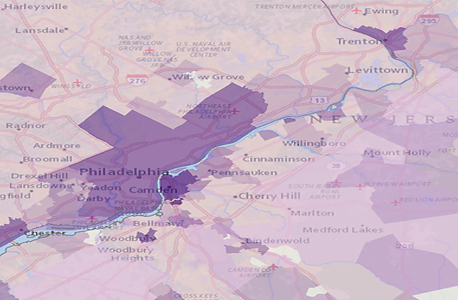How Socioeconomic Conditions Correlate with Access to Technology Among Students
This map details the Delaware Valley’s disparities in terms of children that live in a household with access to at least a single computer (lighter shading denotes a lower proportion). These rates are lowest in the major cities:
Philadelphia (∼9,050 children without access to a device), Trenton (∼560 children), and Levittown (∼300 children), combining for a total of nearly 10,000 young students without access to even a single device.

Poverty within the Delaware Valley (stronger shading denotes a higher proportion of impoverished households). The regions that had the lowest access to technology also feature the highest rates of students living in households that are below the poverty line (Philadelphia: 28.5%, Trenton: 32.7%, Camden: 43.5%).
The main correlation between these two figures supports a fairly intuitive conclusion: students of better socioeconomic circumstances are more likely to have access to devices. In the Deleware Valley, this has further implications: the divide that exists is largely geographical (split between urban and suburban communities) and also exists heavily on racial lines, disproportionately affecting Black and Hispanic-majority communities.
Without intervention and support, students that attend districts in the aforementioned regions will continue to lag behind their peers from more well-resourced districts in terms of access and understanding of technology. There are several consequences, both short and long-term, that will continue to plague these populations unless the disparities are addressed.
In the short term, students will simply be unable to experience the benefits of technology in their education. The incorporation of technology and student devices into learning has done wonders: increased educational efficiency, enabled greater collaboration, and broadened access to online resources. However, for affected students, the revolutionary benefits are inaccessible. These more immediate consequences will be exemplified through data such as district testing and other academic indicators.
In the long-term, there will be an evident divide in terms of skills and knowledge between students that are and are not affected by the digital divide (not considering post-secondary education). Given the rapid digitalization of the economy and labor force, lacking a strong grasp of technological skills will certainly be a detriment in career options and opportunities.

